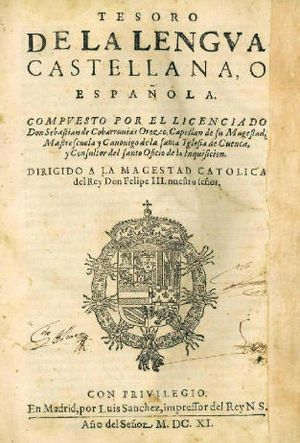Tesoro de la lengua castellana o española facts for kids

The Tesoro de la lengua castellana o española (which means Treasury of the Castilian or Spanish Language) is a very old dictionary of the Spanish language. It was written by Sebastián de Covarrubias in 1611. This book was the first dictionary of the Spanish language that defined words using only Spanish. It was also one of the first dictionaries in Europe to explore where words came from (their etymology) in a common language, not just Latin.
How the Book Was Made
Sebastián de Covarrubias started writing the Tesoro de la lengua castellana o española in 1605. He worked on it for three years in Valencia and Cuenca. Covarrubias was 66 years old when he began. He decided to include fewer words after the letter 'C' because he worried he might not finish the whole project before he died.
Covarrubias wanted to create a dictionary that showed the origins of Spanish words. He was inspired by a book called Etymologiae by Isidore of Seville, which did the same for Latin words. Covarrubias believed that knowing a word's original form could help understand its true meaning. He was especially interested in connecting Spanish words to Hebrew, which some people thought was the first language ever. He also knew about other dictionaries being made in Europe at the time. His main goal was to show people from other countries how special and elegant the Spanish language was.
How the Words Are Organized
The dictionary has about 11,000 main entries. If you count all the words that are explained within other entries, it covers about 17,000 word origins.
The words are not always in perfect alphabetic order. Also, the spelling of words can change throughout the book. This is because Spanish spelling was not yet fixed when Covarrubias wrote the dictionary. He liked the idea of spelling words the way they sound, but even his own spelling was not always the same.
The book includes many different kinds of words. It has words used in specific regions, slang words, special words used in certain jobs (jargon), and very old words (archaism) that were not common anymore. Some entries are short, just a few lines, while others can be very long, even up to eight pages. Most entries are about ten to twenty lines long.
Sometimes, words that have the same root are grouped together, which can make it a bit hard to find a specific word. Words with several related meanings (called polysemic words) are sometimes given their own separate entries, but sometimes they are all explained in one entry.
Each entry in the dictionary is a mix of language information and general knowledge. The language parts include definitions, examples from literature, Latin versions of words, and their origins. The general knowledge parts explain what the word refers to, its symbolism, stories related to it, and other interesting facts. Most entries usually have a definition and the word's origin.
The Supplement
Between 1611 and 1612, Covarrubias started working on an extra part for his Treasury. This supplement added new words and more information to entries already in the first book. It included 2,179 new articles. Most of these were about proper names (like names of people or places). Only a small number (429) were about common words, and 219 of those were completely new entries. The supplement paid special attention to old words and words used in specific technical fields.
In 2001, a part of Covarrubias's supplement was published. It came from a handwritten copy found in the National Library of Madrid.
See also
 In Spanish: Tesoro de la lengua castellana o española para niños
In Spanish: Tesoro de la lengua castellana o española para niños

